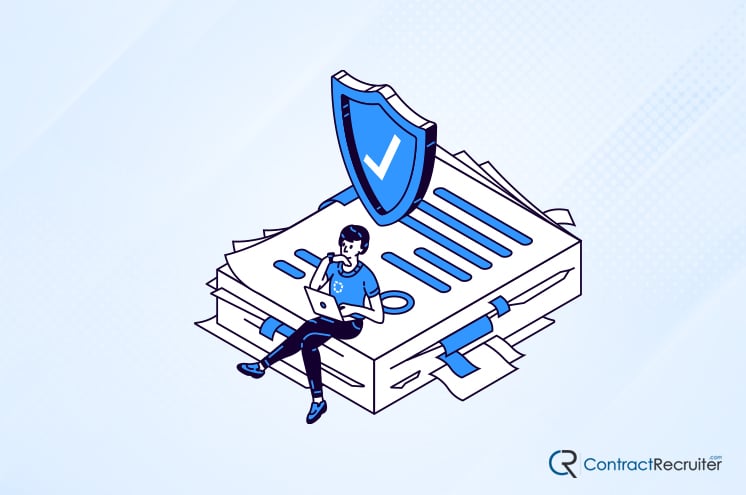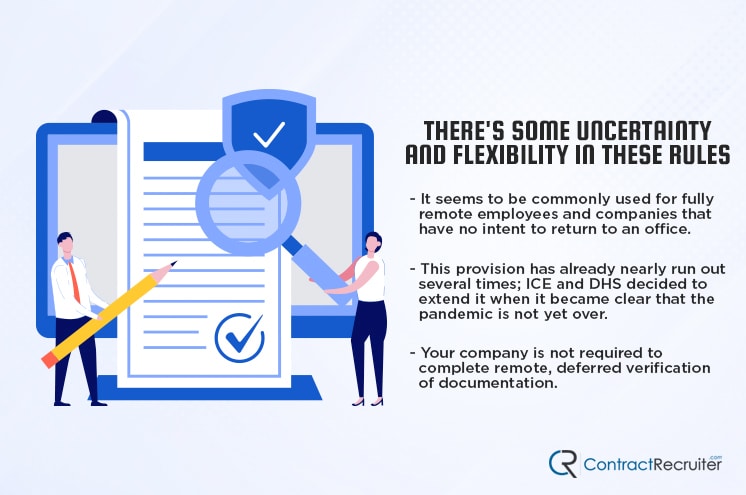The United States form I-9 is an essential document for anyone seeking employment. It’s the “Employment Eligibility Verification” form, and it verifies that the individual being hired is who they claim to be and is eligible to work in the United States. It’s required for both citizens and non-citizens of the United States and needs to be filled out by both employers and employees.
In most cases, this is fine. You meet with the new hire as part of the hiring process. You ask them to bring their documentation with them to the meeting – things like government ID, passport card, or green card, items from the acceptable documents list – and examine them while they’re present. They sign the paperwork, you sign the paperwork, and they’re good to go.
Things get a little more complicated for remote employees. What happens if the employee you’re hiring is hundreds or thousands of miles away?
Fast Track Your Hiring Process with Contract Recruiter Services
The Problem with Remote Hires
The biggest problem with hiring someone remotely is properly filling out the I-9 form. Two restrictions get in the way.
The employee must have a signed and verified I-9 before they can begin work.
This restriction requires that the employee have their paperwork processed and verified by the government of the United States before they can begin working for your company. This requirement doesn’t sound like a tall order, but what happens if you need to rush to hire new people for your company, but they live remotely? They can’t start working legally until the paperwork is processed, and that takes time when you factor in mailing forms and documentation back and forth. Though, with enough preparation, this shouldn’t be a problem. The problem comes when you combine it with the second restriction.
The documentation provided by the employee must be originals, examined in person.
The key sticking point here is that the documents must be examined in person and be the originals. That means that you cannot have the prospective employee show you their documents via a Zoom call or webcam chat because it’s not an in-person examination. It also means that they cannot photocopy and send you the copies in the mail to examine because they aren’t originals. Any way you can think of to get around this is likely something the government explicitly forbids.
This restriction means you have a few limited options.
- The prospective employee can mail you their documentation to examine. This option is terrible; mail can get lost, and sensitive documents are extremely important. Plus, the time delay of the mail still adds at minimum several days before the employee can get processed.
- The prospective employee can make a trip to your office with their documentation to be processed. This option is costly, time-consuming, and may be impossible if the employee would need to enter the country when they don’t have the authorization to do so.
Luckily, the government offers one way around this: authorized representatives.
Using an Authorized Agent to Verify Documentation
According to the USCIS, an authorized agent can complete I-9 paperwork for a remote hire. Specifically:
“Employers may designate an authorized representative to fill out Forms I-9 on behalf of their company, including personnel officers, foremen, agents, or notary public. The Department of Homeland Security does not require the authorized representative to have specific agreements or other documentation for Form I-9 purposes. If an authorized representative fills out Form I-9 on behalf on the employer, the employer is still liable for any violations in connection with the form or the verification process.
When completing Form I-9, the employer or authorized representative must physically examine, with the employee being physically present, each document presented to determine if it reasonably appears to be genuine and relates to the employee presenting it. Reviewing or examining documents via webcam is not permissible.
If the authorized representative refuses to complete Form I-9 (including a signature), another authorized representative may get selected. If the employer hires a notary public, the notary public is acting as an authorized representative of the employer, not as a notary. The notary public must perform the same required actions as an authorized representative. When acting as an authorized representative, the notary public should not provide a notary seal on Form I-9.”
Thus, the primary solution to the remote work problem is to contact a representative in the same location as the prospective employee, most typically a notary public.
This authorized agent is responsible for the employment verification and signing of the I-9 form, and, as such, is in a trusted position. Should the designated agent verify fraudulent documents, the employer is still liable, but there may also be repercussions for the agent.
However, there are occasional troubles with using a notary public; many notaries don’t know what to do when presented with an I-9 and may refuse service.
John Fay, via SHRM, recommends building a list of potential agents a prospective employee can contact for the service.
“‘The employer can list the best possible choices based on prior experience and include any additional instructions or guidance which might be helpful,’ Fay said. He recommends clients consider HR professionals at nearby organizations, local librarians, attorneys or accountants, state workforce agency staff, or notaries. A nationwide listing of notaries can be found here. ‘It’s best to choose an individual who is already familiar with the Form I-9 process to ensure a smooth and quick verification process,’ Fay said. It’s also important to know which states may prohibit notaries from completing the Form I-9 or have different requirements. ‘California, for example, has indicated that the completion of an I-9 form requires you to be bonded as an immigration consultant.'”
As the employer, it is not necessarily your responsibility to pick a specific agent in the location of the prospective employee. If you do the legwork to identify and contact such an agent ahead of time, and recommend that particular agent to your employee, it can streamline the process. However, they are also free to find anyone willing that meets the requirements of being an authorized agent.
As Fay says, some states like California may have specific, additional requirements for verification of the form I-9.
Luckily, the actual requirements for an authorized agent are generally minimal. The agent needs to inspect the documentation and certify that, to the best of their knowledge, the documents are legitimate and in order. They do not need to notarize the form, nor do they need to go to exceptional lengths to verify the documentation.
Fast Track Your Hiring Process with Contract Recruiter Services
The Impact of COVID-19 on Form I-9 Completion
The global Coronavirus pandemic has, for a good reason, put a damper on a lot of different governmental and social processes.
In particular, the requirement that documents get inspected in person has become dangerous, both to the authorized agent and the prospective employee. Many sources of authorized agents, such as libraries, also may not be open or available during quarantines or lockdowns.
This problem throws an additional wrench into the plan to verify remote employees. This is made even worse because many businesses are transitioning to either temporary or permanent remote work for some or all of their employees, and many more are starting to hire remote employees when they never had to do so before. How do you navigate the Form I-9 problem if you’re in this situation?
The answer is temporary waiving of requirements from the government. Agencies including Immigration and Customs Enforcement and the Department of Homeland Security have implemented temporary policies to waive the physical inspection of documentation. Here’s what they now require:
- You are not required to inspect the documentation in person.
- You are still required to inspect the documentation but can do so over a digital means such as email, video call, or fax.
- You have to acquire copies of the relevant documentation within three days for the purposes of section 2 of the I-9.
Additionally, this is a deferment, not a waiver. When these restrictions are lifted and normal operations resume, you will be required to submit an amended form with an appropriate physical examination of the documents and “Covid-19” listed as the reason for the delay.
It’s worth mentioning that there’s some uncertainty and flexibility in these rules.
- Though the rules were initially meant for companies offering temporary remote work for employees who will eventually work in person, it seems to be commonly used for fully remote employees and companies that have no intent to return to an office, with no repercussions as of yet.
- This provision has already nearly run out several times; ICE and DHS decided to extend it when it became clear that the pandemic is not yet over (indeed, it is worse than ever) and is, as of this writing currently, extended through April 30, 2022. Check this page, or this page for the most up-to-date information on the new policies and deadlines.
- Your company is not required to complete remote, deferred verification of documentation. If you and your prospective employee are willing to do so and can find an authorized agent willing to do so, verification can be performed as normal. This can be taken on a case-by-case basis for each remote employee.
It’s also possible that the remote verification rules may be made permanent. As of the end of 2021, DHS was seeking comments on whether or not the new rules should be made permanent to ease the burden on hiring remote workers. After all, global, modern communications methods have made it easier than ever to hire fully remote workers from around the globe. Requiring steep barriers to verification of documentation puts an unnecessary damper on that ability.
Comments were accepted until December 27, 2021. Currently, the agencies are reviewing the comments and will be making their decision at some future point. You can read more about it here.
Is it likely to succeed? That remains to be seen. This experiment may have shown DHS and ICE that there is very little to be gained through in-person verification and that the inspection does little to combat fraud while placing an undue burden on businesses to arrange it. On the other hand, we all know that government agencies are slow to change, so it’s possible that reverting to the old rules is in the cards.
“Leading technology companies have made recent advancements in document capture that paves the way for an automated review of an I-9 document with a higher level of confidence relating to its authenticity and validity.” – John Fay.
Perhaps the most likely result will be the establishment of specific rules and technologies, as well as a dedicated system for verifying documentation remotely. What form this will take, however, remains to be seen.
What Should Your Company Do?
If your company is looking to hire a remote employee, the first thing to do is check the links to DHS and ICE to see if the current rules have changed since the time of this writing.
If remote validation is still allowed, do that. You should make sure that you have notes taken and are prepared if such a time comes that you will be required to submit manual verification of the documents and an amended I-9. That may or may not be necessary, depending on the decisions made by the government in the coming months and years.
Should you consider not hiring remote employees? No. The benefits of hiring remote employees far outweigh the drawbacks of navigating a tricky situation for their employment documentation. The broader talent pool, the flexibility of a remote team, and the quality of work done while keeping employees safe during a pandemic are all too important to lose simply to avoid working with a complicated form process.
Have you had issues filing or verifying the form I-9 in the past, or since the pandemic started and the rules were relaxed? If so, please discuss them in the comments below. Additionally, if you have any further questions regarding filling out the Form I-9 properly or require any assistance, please feel free to leave a comment down below, and we’ll get a conversation started!
Streamline Onboarding with Contract Recruiter
Contract Recruiter can help streamline your entire recruitment and onboarding process, including
I-9s. Our expert team takes the burden off your shoulders, ensuring a seamless and efficient recruitment process from start to finish. Get in touch with us today!
Fast Track Your Hiring Process with Contract Recruiter Services





